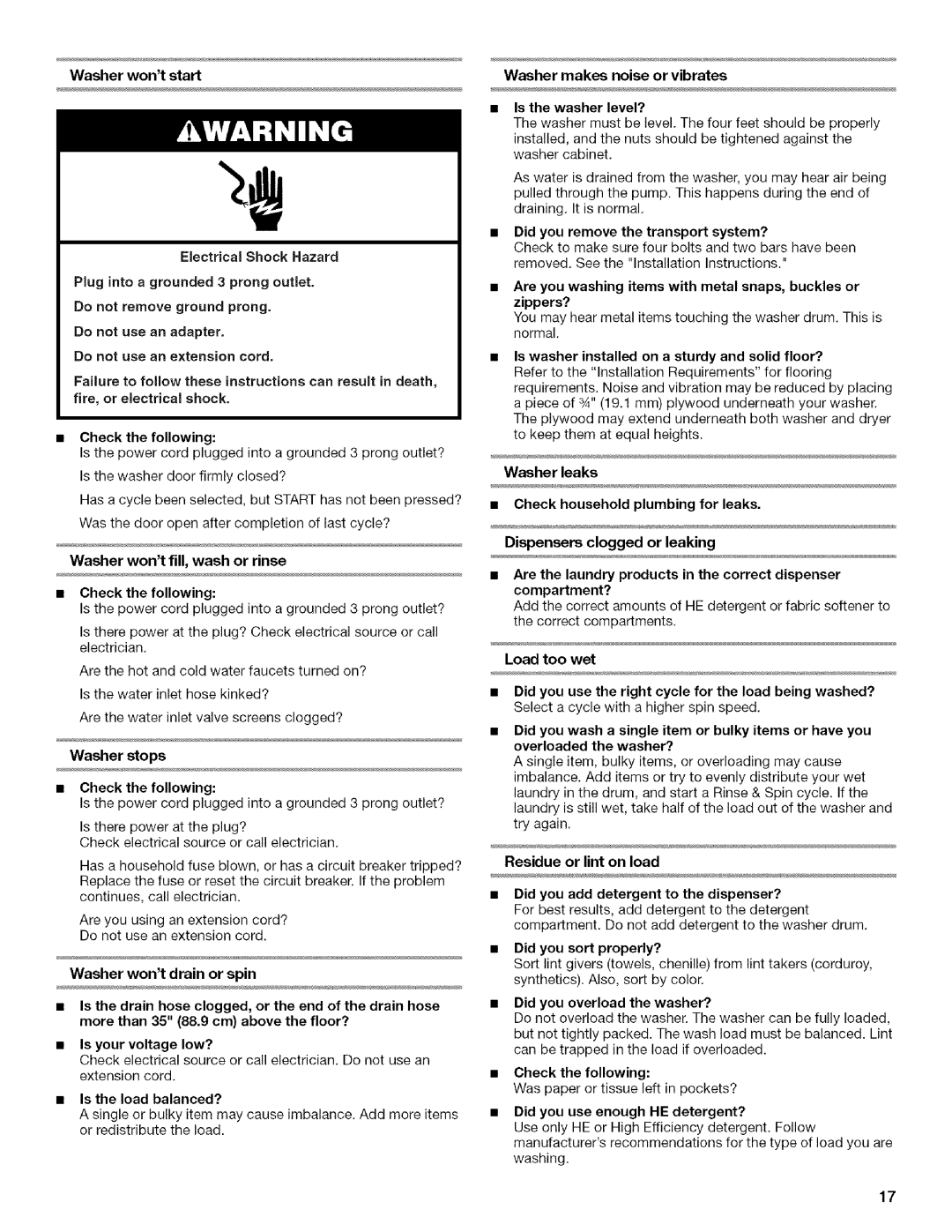
Washer won't start
Electrical Shock Hazard
Plug into a grounded 3 prong outlet.
Do not remove ground prong.
Do not use an adapter.
Do not use an extension cord.
Failure to follow these instructions can result in death, fire, or electrical shock.
•Check the following:
Is the power cord plugged into a grounded 3 prong outlet? Is the washer door firmly closed?
Has a cycle been selected, but START has not been pressed? Was the door open after completion of last cycle?
Washer won't fill, wash or rinse
• Checkthe following:
Is the power cord plugged into a grounded 3 prong outlet?
Is there power at the plug? Check electrical source or call electrician.
Are the hot and cold water faucets turned on?
Is the water inlet hose kinked?
Are the water inlet valve screens clogged?
Washer stops
•Check the following:
Is the power cord plugged into a grounded 3 prong outlet?
Is there power at the plug?
Check electrical source or call electrician.
Has a household fuse blown, or has a circuit breaker tripped? Replace the fuse or reset the circuit breaker. If the problem continues, call electrician.
Are you using an extension cord? Do not use an extension cord.
Washer won't drain or spin
•Is the drain hose clogged, or the end of the drain hose more than 35" (88.9 cm) above the floor?
•Is your voltage low?
Check electrical source or call electrician. Do not use an extension cord.
•Is the load balanced?
A single or bulky item may cause imbalance. Add more items or redistribute the load.
Washer makes noise or vibrates
Is the washer level?
The washer must be level. The four feet should be properly installed, and the nuts should be tightened against the washer cabinet.
As water is drained from the washer, you may hear air being pulled through the pump. This happens during the end of draining. It is normal.
•Did you remove the transport system?
Check to make sure four bolts and two bars have been removed. See the "Installation Instructions."
Are you washing items with metal snaps, buckles or zippers?
You may hear metal items touching the washer drum. This is normal.
Is washer installed on a sturdy and solid floor? Refer to the "Installation Requirements" for flooring requirements. Noise and vibration may be reduced by placing a piece of 3A" (19.1 mm) plywood underneath your washer. The plywood may extend underneath both washer and dryer to keep them at equal heights.
Washerleaks
•Check household plumbing for leaks.
Dispensers clogged or leaking
Are the laundry products in the correct dispenser compartment?
Add the correct amounts of HE detergent or fabric softener to the correct compartments.
Load too wet
•Did you use the right cycle for the load being washed? Select a cycle with a higher spin speed.
Did you wash a single item or bulky items or have you overloaded the washer?
A single item, bulky items, or overloading may cause imbalance. Add items or try to evenly distribute your wet laundry in the drum, and start a Rinse & Spin cycle. If the laundry is still wet, take half of the load out of the washer and try again.
Residue or lint on load
•Did you add detergent to the dispenser?
For best results, add detergent to the detergent compartment. Do not add detergent to the washer drum.
•Did you sort properly?
Sort lint givers (towels, chenille) from lint takers (corduroy, synthetics). Also, sort by color.
•Did you overload the washer?
Do not overload the washer. The washer can be fully loaded, but not tightly packed. The wash load must be balanced. Lint can be trapped in the load if overloaded.
•Checkthe following:
Was paper or tissue left in pockets?
•Did you use enough HE detergent?
Use only HE or High Efficiency detergent. Follow manufacturer's recommendations for the type of load you are washing.
17
